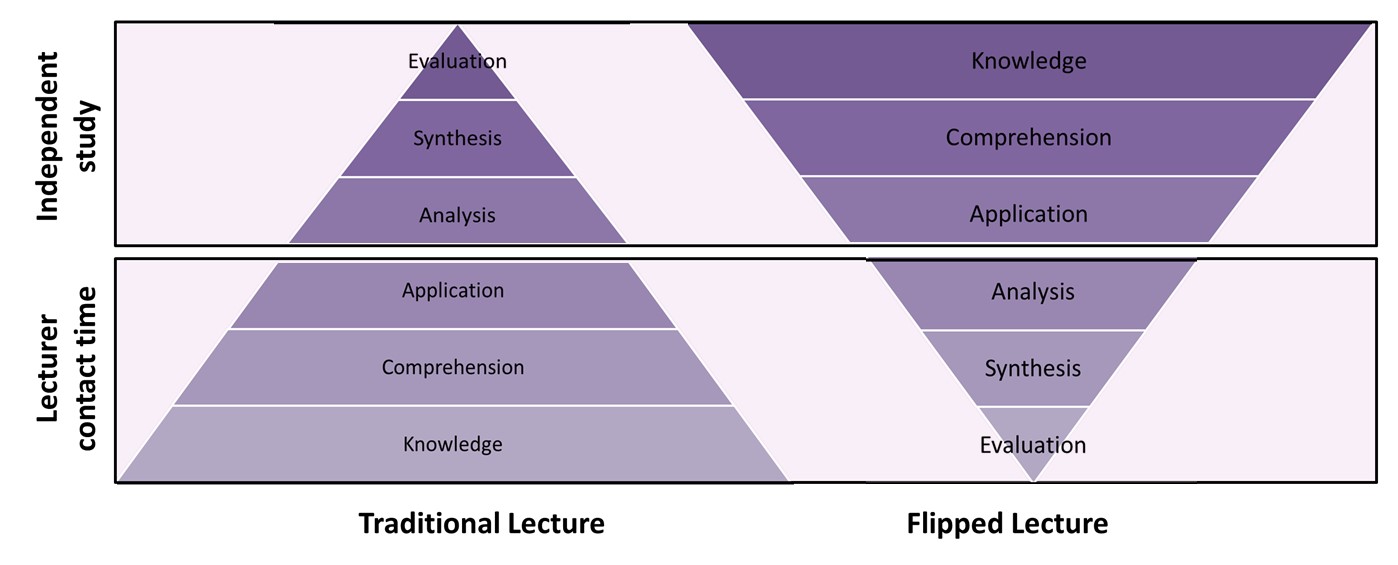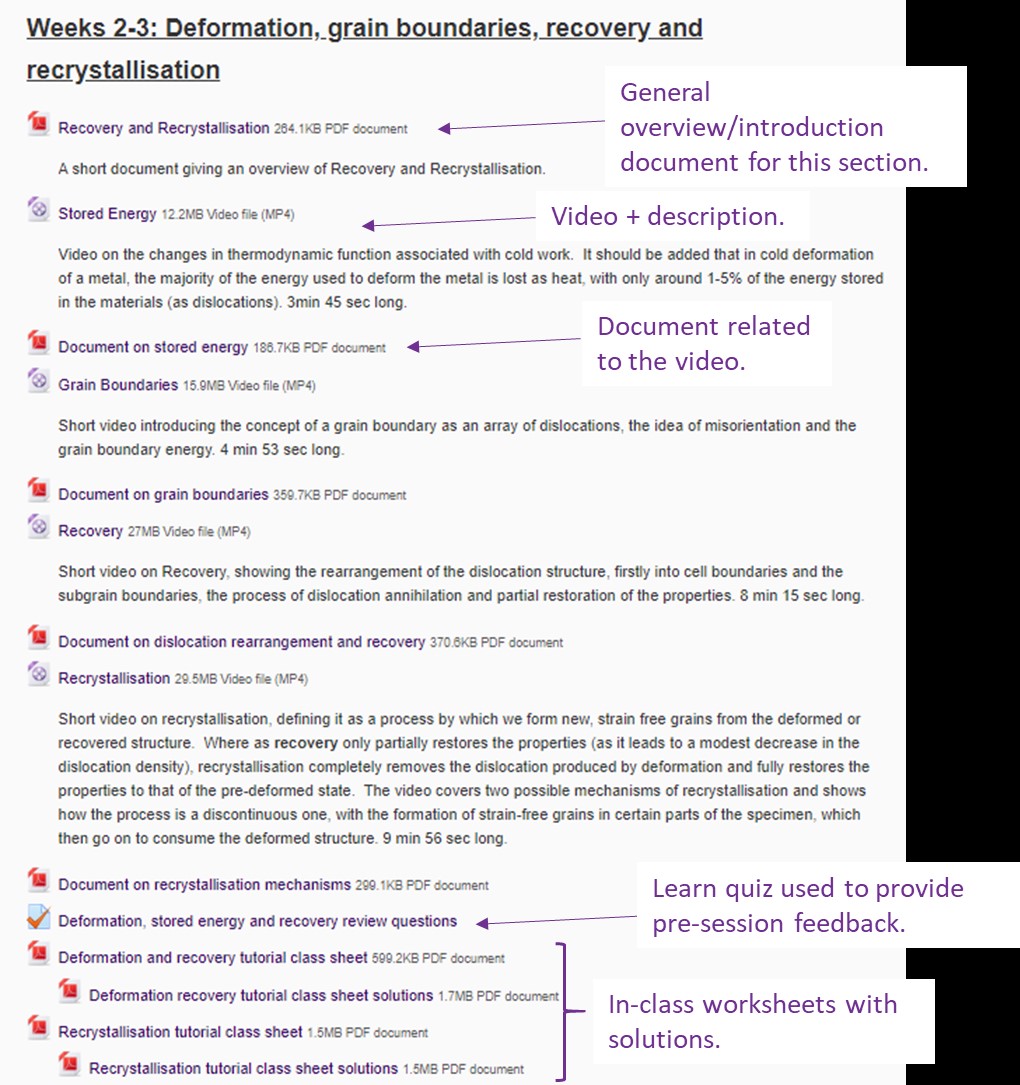Case Study - Lecture flipping for enhanced student engagement
Simon Hogg - Department of Materials
Background
The idea of lecture flipping for enhanced student engagement was originally developed as part of a teaching innovation award in 2014 with co-investigators Dr. Nicola Jennings (Chemistry) and Dr. Mark Jepson (Materials). The funding was used primarily to run a workshop with external speakers well known as lecture flipping practitioners. For a good overview of the session search for #flipart14 in Twitter. I then used ideas developed during the workshop and with CAP colleagues to develop and deliver two fully flipped modules – a Part A Thermodynamics module and a Part B module called Engineering Alloys that covered the underlying theory of metal behaviour in engineering applications.
Methodology
The basic idea of lecture flipping is shown schematically below:

In a conventional lecture, the session is often dedicated to information transfer and lower level learning objectives, e.g. transfer of knowledge, some initial building of comprehension, maybe limited application of the knowledge, with higher level learning assumed to be carried out in independent study time. In a flipped lecture, the lower level learning objectives are carried out by the students during independent study time, and the contact time in the lecture is fully devoted to addressing higher levels learning outcomes such as analysis, synthesis and evaluation - where the students typically need more help. (See Bloom et al. [1] for more on the taxonomy of educational objectives (Bloom’s Taxonomy) with a more recent revision of the taxonomy given in reference [2].)
How did I do this?
I made the early decision that there would be no conventional (knowledge-transfer focussed) face-to-face lectures at all. The task of knowledge-transfer was completely delegated to the students. Expectations were clearly and carefully set during the first lecture as to why we were doing this (e.g. improved attainment [3]), and clear instructions were given as to how the students could/should approach and with engage the content. A short explanatory document, also provided to the students, is available at the button below.
The content was delivered primarily via short (~5-15 minute) videos which focused on the key concepts related to the module learning outcomes. There was no PowerPoint at all. All video content was delivered in the form of screencasts with voice-over produced predominantly using an iPad with the Explain EDU app. Although not free (at the time of writing, it has a one-time purchase cost of £13.99 from the App store) and only available for iOS devices, I found it easy to use and the features allowed me to easily produce and edit content. Other options to produce such content could include:
- Using a visualiser in a lecture room with Panopto.
- A smartphone or a webcam with a flexible arm to double as a visualiser such as HUE (a blog related to the use of such cameras is given in the references section) and Panopto and/or Teams to capture the screen. See this case study for a further example of using a homemade visuliser for live delivery.
- The Whiteboard feature in Teams (contact CAP for further details and help about this).
The videos were loaded directly to Learn and made available at least 1 week in advance to provide structure. The figure below shows the structure of a typical Learn page.
A smart phone or a webcam with a flexible arm to double as a visualiser such as HUE (a blog related to the use of such cameras is given in the references section) and Panopto and/or Teams to capture the screen.
Each video had a clear description, including the length of the video. Early feedback was that students did not like just videos, so I added a short accompanying document to each video.

An example document can be downloaded using the button below and an example video can be seen below.
Face-to-face sessions were based around an in-class problem sheet with discussion and calculation-type questions. These were also made available in advance. Students worked together in groups (promoting peer instruction is key) during the sessions to complete the questions. I would facilitate students needing help and leave alone those who were happy and able to work to complete the questions. This was generally split between those that engaged with the content in advance and those that did not – see section 5 Evidence of Success. The content of the worksheets could be based around informal questions you may typically ask students in lectures, shortened version of more in-depth tutorial questions, questions taken from past exam papers etc.
I would also make time to work through the answers with students in the session to give feedback and provide an opportunity for students to ask questions and this would often lead to an opportunity for further discussion. Full worked solutions to the questions were made available immediately after the session. A typical document with solutions is available at the button below.
Issues
The biggest issue is that this approach requires a lot on up-front time commitment to think about, develop and produce the content. It is very easy to fall into a trap of endlessly re-recording videos to make them perfect, and this makes the process incredibly time consuming. Consider the balance of preparation time vs. the benefit. I would also recommend not writing a full script as this can make the delivery sound rather stale, but I found it useful to ‘storyboard’ the video, with bullet points of the key points that should be covered. This helped to avoid missing important points, which may mean having to redo the video.
Benefits
Having done this for a few years on two modules, the key benefit is that it is a more engaging and stimulating learning environment with enhanced opportunity for interaction with and between the students. Additional benefits include:
- Material available to students during revision.
- More freedom within the class to explore topics to clarify understanding of the students.
- More chance to deepen understanding by asking probing questions and debating student responses.
Evidence of Success
Below is an example of positive student feedback:
“I think that the most useful thing is to have an easy to access source of the information needed for the course whether that be in written or video format. The flipped lectures are good because the core learning can be done outside the lectures leaving time for help and questions in the lectures themselves.”
Not all students liked the approach. Here is an example of less-positive feedback, but the student did at least recognise some potential benefits to the approach.
“I found it a bit more difficult. This subject seemed fairly difficult for me to get my head around anyway. On the other hand when we were in class we actually got to apply the knowledge through work sheets but if you didn’t watch the videos you had no idea of what to do. Overall i did not prefer this teaching method but not because it was a poor learning experience it was just because it was different to the normal structure and required a lot of independent study.”
How Can Other Academics Reproduce This?
This really works well if your module deals with concepts and you can reduce the module content to focus on key points and/or ideas. Exactly how you produce the content will depend on your preference and the subject, but a well-structured format of short videos and chunks of content work well. The important point is that the content should act as a vehicle to encourage peer interaction in the class sessions.
Reflections
One initial worry was that student attendance would be affected. However, student attendance was good (even at 9am on a Monday morning). It is important to make the in-class activities engaging and well aligned to the content on Learn and to make sure that the students work together in the class. Facilitating peer instruction places the responsibility on the student for their own learning – and students appreciate this.
It took the students (much) longer to complete the in-class activities that I expected, so I needed to recalibrate my expectations after the first few sessions.
I found recap sessions between each main subject within the module helped to break up the content and provide feedback to the students. A combination of simple true/false questions and some more in-depth questions worked very well.
Notably, it was a rewarding experience relative to ‘conventional’ lecturing, but the amount of time it takes to think about and create the content was an issue.
References
[1] Bloom, B., Englehart, M., Furst, E., Hill, W. & Krathwohl, D., Taxonomy of Educational Objectives: The Classification of Educational Goals. Handbook I: Cognitive domain, Longmans, Green and Co. Ltd. London, 1956.
[2] Krathwohl, D.R., A Revision of Bloom's Taxonomy: An Overview, Theory into Practice, 2002, 41:4, pp. 212-218
(https://www.depauw.edu/files/resources/krathwohl.pdf)
[3] Weaver G.C. & Sturtevant, H.G., Design, Implementation, and Evaluation of a Flipped Format General Chemistry Course, J. Chem. Educ., 2015, 92, pp. 1437-1448
[4] Mazur E., Farewell, Lecture?, Science, 2009, 323, pp. 50-51
http://michaelseery.com/capturing-hand-writing-in-desktop-lecture-capture/